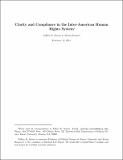| dc.contributor.author |
Jeffrey K. Staton and Alexia Romero |
| dc.coverage.spatial |
United States |
| dc.date.accessioned |
2016-01-07T15:20:40Z |
| dc.date.available |
2016-01-07T15:20:40Z |
| dc.identifier.uri |
http://desa1.cejamericas.org:8080/handle/2015/448 |
| dc.description.abstract |
This paper leverages a highly detailed, public monitoring system for decisions of the Inter-American Court of Human Rights (IACHR) to test a model of judicial policy implementation. We model the clarify with which the IACHR expresses its remedies to human rights violations in the context of its contentious jurisdiction. We also model the reactions of states to these remedies. Our findings suggest that clarity lowers resistance to IACHR orders, yet uncertainty about the relationship between policy means and policy ends renders IACHR order less clear. These findings are consistent with general claims in judicial politics about the interdependence of the judicial policy-making process. They also suggest that international judicial reform efforts designed to advance judicial independence without considering the challenges of policy implementation are not only unlikely to succeed but misguided normatively. |
| dc.title |
Clarity and Compliance in the Inter-American Human Rights System |
| dc.ceja.source |
Fuente: Emory University |

